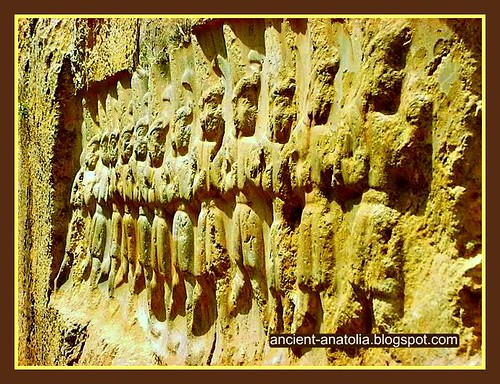
Twelve Hittite gods of the underworld, rock carvings Yazilikaya (Turkish for "inscribed rock"), a sanctuary of Hattusa, the capital city of the Hittite Empire, today in the Çorum Province, Turkey.
This was a holy site for the Hittites living in the nearby city of Hattusa. Most impressive today are the rock-cut reliefs portraying the gods from the Hittite pantheon. There were also shrines built adjacent to the rocks. It is believed that New Year's celebrations took place at the site. The sanctuaries were used from the fifteenth century BC, but most of the rock carvings date to the reign of the Hittite kings Tudhaliya IV and Suppiluliuma II in the late 13th century BC.
The most impressive Chamber is Chamber A, which contains rock-cut relief of 64 deities in procession. The left wall shows a procession of male deities, wearing the traditional kilts, pointed shoes and horned hats. Mountain gods are also shown with scaled skirts to symbolise the rocky mountains. The right wall shows a procession of female deities wearing crowns and long skirts. The only exception to this divide is the goddess of love and war, Shaushka (Mesopotamian goddess Ishtar/Inanna) who is shown on the male procession with two female attendants. This is likely to be because of her male attributes as the goddess of war. The processions lead to a central scene of the supreme couple of the pantheon; the storm-god Teshub and the sun-goddess Hebat. Teshub stands on two mountain gods whilst Hebat stands on a panther. Behind Hebat are shown their son Sharruma, daughter Alanzu and a granddaughter.
It is intriguing to note how the Hittite practise of assimilating other cultures' gods into their own pantheon is in evidence at Yazilikaya. The Mesopotamian god of wisdom, Ea (Enki) is shown in the male procession and the god Teshub was a Hurrian god who replaced the Hittite storm god. Hebat's original consort is changed into her and Teshub's son (Sharruma) and she is later synchronized with the Hurrian sun goddess of Arinna. Much of this is attributed to the wife of Hattusili III, Puduhepa, who was the daughter of a Hurrian priestess.
More on:
Hittites...
History of Hittites...
Hittite sculptures...
O Cybele, Mother Goddess...
Earliest urban societies...
Expedition in ancient Anatolia...
Ancient Hittite dam...
Hattusa, ancient capital city of Hittites...
Before the Hittites: Hattians, first civilizations in Anatolia...
Hittites in the Bible...PHOTO: Twelve Hittite Gods of the Underworld by ancient-anatolia.blogspot.com